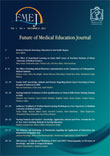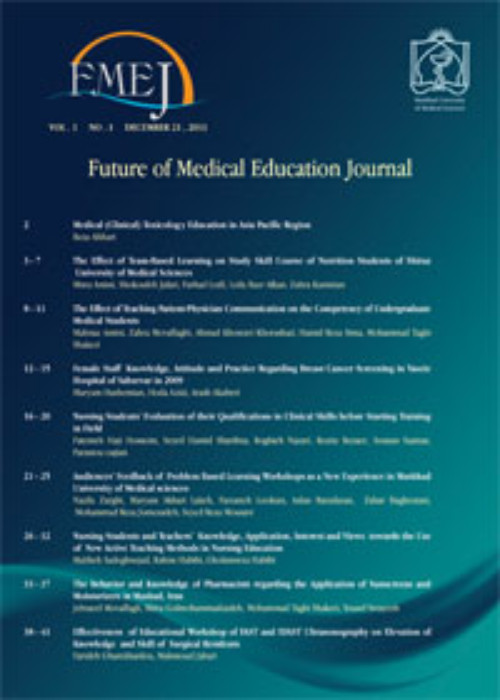فهرست مطالب

Future of Medical Education Journal
Volume:5 Issue: 4, Dec 2015
- تاریخ انتشار: 1395/01/11
- تعداد عناوین: 9
-
-
Pages 6-10BackgroundThe counselors are responsible for academic counseling to students and help them to solve their educational problems. The aim of the present study was to determine the viewpoints of students about the status of academic counseling provided by the faculty advisers in four schools at University of Medical Sciences.MethodsIn this cross-sectional study, the opinions of 244 students about the counseling status in four schools of Medicine, Nursing and Midwifery, Public Health, and Paramedical were assessed by a self- designed Check List including individual and educational information and 12 items with Likert scale to assess the students viewpoints about the status of counselingin the first semester of 2012. Data were analyzed by SPSS (v.16), using mean (SD), one-way ANOVA and Pearson correlation test.ResultsChecking and signing form of credit selection was the only item from the 12 items of counseling status to which the students in four schools had given a higher score [School of Medicine (2.47±0.60)], [School of Para-medicine (2.45±0.66)], [School of Health (2.10±0.90)], [School of Nursing and Midwifery (2.50±0.86)] and there was no significant difference among the schools (P=0.50).ConclusionsFrom the viewpoints of students, the status of counseling was not good. Informing the advisors about their duties and adequate supervision of university officials on proper implementation of counseling by the faculty members can help to improve the process of advising.Keywords: Educational Counseling, Students, Viewpoints, University of Medical Sciences
-
Pages 11-15BackgroundCancer is the third leading cause of death in Iran. Novel chemotherapeutic agents can lead to considerable improvements in cancer treatment, although using these agents requires special skills and experiences. The aim of this study was to evaluate the impact of a short course education on nurses knowledge and attitude.MethodsOverall, 24 nurses participated in this short educational course, supervised by several clinical/radiation oncologists. During a two-week period, several protocols of chemotherapy, complications associated with chemotherapy, and the management of adverse outcomes were taught to the participants with a special emphasis on nursing considerations. Before the program and at the end of the course, the Multiple Choice Questionnaire (MCQ) and Direct Observation of Procedural Skills (DOPS) were used for evaluating the effectiveness of the program on the participants knowledge. Changing their attitude was also evaluated by an author-made Questionnaire. The mean knowledge and attitude scores before and after the interventions were compared using paired t-test.ResultsOverall, Four participants (16%) were male and 20 (83%) were female. The majority of the subjects (90%) worked at chemotherapy wards. Sixteen (66%) versus twenty two (91%) nurses achieved a minimum score of 70% on MCQ before and after the course, respectively (p=0.03). The mean scores before and after the course were 18.7±8.6 versus 26±11 for MCQ (p=0.03) and 30.3±10 versus 45.3±14 for DOPS (p=0.004). The mean of attitudes score were 3.93±1.7 and 4.04±1.2 before and after the course, respectively, that showed a significant difference (p=0.01).ConclusionsShort educational courses about major subjects in oncology nursing could improve nurses knowledge and attitude.Keywords: Chemotherapy, Education Course, knowledge, attitude, Nurses
-
Pages 16-20BackgroundBased on researches done in recent decades, there are several therapeutic approaches to increase self-esteem and achievement motivation of students. Among these methods, we can refer to cognitive-behavioral therapy. The purpose of this research is assessment of effectiveness of cognitive-behavioral group training on self-esteem andachievement motivation of students.MethodsThe research method was experimental with two- grouped pre-test and post- test design, experimental group and control group. The statistical population includes all students of high schools in Sarakhs (educational year 2012-2013). (N=85). Participants were chosen by available sampling method and randomly assigned to an experimental (15 boys) and a control group (15 boys). The experimental group received cognitive-behavioral group training through 8 sessions of 1 hour, while the control group received no training at all. For assessing the research variables, Alis Pop self- esteem questionnaire and Edwardss achievement motivation questionnaire were done before and after completion of the trainings. The collected data were analyzed using independent and dependent T test by SPSS statistical software.ResultsThe study demonstrated that cognitive-behavioral training had positive effects on students self-esteem (PConclusionsIn general, it can be concluded that cognitive- behavioral training were found effective in increasing self-esteem and achievement motivation.Keywords: Cognitive Behavioral Training, Self, esteem, Achievement Motivation, Students
-
Pages 21-24BackgroundCommunication is very important in human societies in connection with the exchange of ideas and information between the instructor and student. The current research aimed to study factors that influence the interaction between the instructor and student from the perspective of Shushtar medical sciences students.MethodsThis descriptive - cross sectional study was conducted in Ahvaz University of Medical Sciences (Shushtar Nursing Branch). Sample size (n = 82) includes nursing students, medical emergencies and operation room. The instrument was a researcher-made questionnaire consisting two parts, the first part included personal characteristics and the second part was related to factors affecting the interaction between teacher and student. After data collection, the data was analyzed descriptively by SPSS software (version 18).ResultsThe results of the present study showed that the average age of participants was 29.63 ± 3.8. Most of them (51.2%) believed that there should be restriction on student-teacher relationships. The majority of the students believed that the existence of restriction between instructor and students such as indigenous knowledge of Islamic law and ethical standards of communication, counseling, the balance between intimacy and limitations between instructor and students can build confidence and enhance effective communication between teacher and student and improve learning process.ConclusionsAccording to the results of the professional characteristics and teaching, workshops can reinforce the skills of teachers and improves education.Keywords: Interaction, Teachers, Students
-
Pages 25-29BackgroundRapid advancement of information and communication technologies has transformed the methods of education. It has created methods which help students achieve deep and effective learning as well as develop a desirable level of creativity. Implementation of e-learning in education is one of such methods. The purpose of the present research is to study the impact of self-learning (self-paced learning) on learning progress and creativity in students of Physiology course of Shahrkoord Medical University in school year 2014-15.MethodsThe present study employs a quasi-experimental design which incorporates pretest-posttest and a control group. The statistical population consisted all nursing students of Shahrkoord University of Medical Sciences studying at the first semester of 2014-15 among whom 40 individuals studying at two separate classes have been selected as sample members using convenient sampling method. The instruments of data collection are the realized learning test (with 0.84 pretest reliability and 0.81 posttest reliability, and face validity confirmed by university professors) and Abedi creativity questionnaire. In order to analyze the data the independent T-test has been carried out using SPSS software Ver.18.ResultsThe results of the study indicated that the use of E-learning in physiology teaching-learning process both improves nursing students learning (by 4.32 points) and increases their creativity (fluency 4.67, originality 8.87, flexibility 4.73, and elaboration 4.32 points).ConclusionsBased on the results yielded by the present study, implementation of e-learning improves creativity and learning in university students in physiology course. Therefore, executives of education system should consider incorporation of e-learning in teaching-learning processes.Keywords: E, learning, Creativity, Physiology Course
-
Pages 30-35BackgroundAcademic tests are valuable tools for evaluating students knowledge and capabilities. This study aimed to assess the content validity offinal examinations at Mashhad Dental School. The practical purpose of this study was to enhance the quality of written examinations in this school.MethodsThe present descriptive, cross-sectional study aimed to determine the content validity of final examination of Mashhad Dental School, located in Northeast of Iran during 2011-2012. In this study, in collaboration with the Education Development Office (EDO) of Dental School, we designed this study to assess the content validity of written tests in the school. The percentage of content coverage (CC) and content relevance (CR) of each item were determined, and the percentage of content validity (CV) was calculated using Messick method. We used frequency distribution tables and diagrams in order to assess the content validity of final examinations.ResultsIn total, 68 faculty members who were designers of exam questions participated in the current study. The mean percentage of CR and CC were 95.2% and 76.87 in the final exams of all departments, respectively. In addition, the mean percentage of content validity was 86.04 in the exams of different groups.ConclusionsExaminations are the most important tools to evaluate students learning; therefore, evaluating the final written examinationsas a measure of students knowledge, can help improve the quality of training. Also, teacher's awareness of the importance of content validity and quantification method is quite effective in designing efficient exams with greater sensitivity.Keywords: Written Test, Content Validity, Evaluation, Dentistry
-
Pages 36-41BackgroundThe perspective of scientific authority in Iran, by the year 1435, requires a growing strong generation with a sense of self-esteem, academic endeavor and responsible in today's competitive world. Strategic planning of human resources and education of youth with talent, commitment, vitality and hope requires a national will along with adequate resources.
The aim of this study was to gain a deep understanding of the challenges and solutions for achieving scientific authority in Iran by the next fifty years.MethodsIn this narrative review, the following items were surveyed: The strategies for scientific authority stated by our Supreme Leader (since Mordad 85 to 94), The study of governmental documents such as the perspective by the year 1404 (since77 to 82.), a comprehensive scientific map for health system (since 89 to 93.), the general policy of "science and technology" (since 86 to 87), and the comments given by health authorities, faculty members and students.Resultsaccess to the scientific authority requires a national commitment and the development of human resources proportional to the aims. The pathology of health activities requires a good understanding of the strengths, weaknesses and threats to define priorities and establishing structures for our goals. In this study the challenges were investigated and the possible solutions have been proposed.ConclusionsSpanning foresight in the field of health in Iran and the world demands the cooperation of our professors with the young innovative scientists. Standardization not only promotes the quality of research projects but also increases the exploitative activities.Keywords: Authority, Science, Health, Research -
Pages 42-45BackgroundClinical training has an important section in medical students education. Creating a favorable learning environment plays an essential role in medical education. Since clinical teachers involve to clinical problem, clinical education environment evaluation can help to identify the negative and positive factors. This study was conducted to compare medical students and resident's perceptions and their teachers of the hospitals educational environment using the Dundee Ready Education Environment Measure (DREEM).MethodsThis descriptive, analysis cross-sectional study was conducted in Kerman University of Medical Science, 2012. Using DREEM investigate the educational atmosphere four main clinical wards (Internal, Surgery, Pediatrics and Gynecology) in the educational hospitals of University. DREEM distributed to 230 participants, included 50 clinical teachers, 88 residents and 92 interns. Statistical analysis was done using SPSS 18. We were carried out Anova test to comparison means items.ResultsThe overall DREEM is 161/200for interns, 157/200 for residents and 123/140 for teachers. Generally tend to positive. There were significant difference in Learning domain (PConclusionsDREEM scores are on the top of scoring except the perception of teachers in domain of learning that it can be causing of satisfies of their performance in learning environment. Participants assessed the educational environment as high level. Regarding the Perception of learning, teacher's performance, and learning atmosphere was viewed positively. So, its better to keep quality in high level in clinical wards.Keywords: Educational Environment, Clinical, DREEM inventory, Learning


